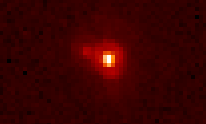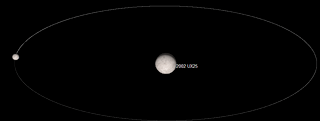(55637) 2002 UX25
 2002 UX25 as seen by Hubble | |
| Discovery [1] | |
|---|---|
| Discovered by | Spacewatch (291) |
| Discovery site | Kitt Peak National Obs. |
| Discovery date | 30 October 2002 |
| Designations | |
| MPC designation | (55637) 2002 UX25 |
|
Cubewano (MPC)[2] Extended (DES)[3] | |
| Orbital characteristics [1] | |
| Epoch 4 September 2017 (JD 2458000.5) | |
| Uncertainty parameter 2 | |
| Observation arc | 25.26 yr (9,228 days) |
| Earliest precovery date | 12 October 1991 |
| Aphelion | 48.491 AU |
| Perihelion | 36.485 AU |
| 42.488 AU | |
| Eccentricity | 0.1413 |
| 276.95 yr (101,157 days) | |
Average orbital speed | 4.54 km/s |
| 295.71° | |
| 0° 0m 12.96s / day | |
| Inclination | 19.484° |
| 204.68° | |
| 279.00° | |
| Known satellites |
1 (ø: 190–260 km)[4][5] |
| Physical characteristics | |
Mean diameter | 665±29 km[6] |
| Mass | (1.25±0.03)×1020 kg[5] |
Mean density |
0.82±0.11 g/cm3 (assuming equal densities for primary and satellite)[5] |
Equatorial surface gravity | 0.075 m/s2 |
Equatorial escape velocity | 0.227 km/s |
| 14.382±0.001 h[7] | |
|
0.107+0.005 −0.008 [6] | |
| Temperature | ≈ 43 K |
|
(pushing red) B−V=1.12 V−R=0.61[8] B−V=0.95 V−R=0.56[9][10] U−B=0.26 B−V=0.98 V−R=0.54±0.03 B−R=1.52 V−I=1.13±0.05 R−J=1.28 V−J=1.82±0.09 J−H=0.4±0.05 V−H=2.22 [7] | |
| 19.8 [11] | |
| 3.87±0.02,[7] 4.0[1] | |
|
| |
(55637) 2002 UX25 is a possible dwarf planet that orbits the Sun in the Kuiper belt beyond Neptune. Its orbit takes roughly 280 years, and it has one known moon. This moon makes it much easier to calculate mass, and when the size is known, also is density. The low density of about 0.82 g/cm3 surprised astronomers.[12]
It is a trans-Neptunian object with an absolute magnitude of 4.0,[1] making it highly likely to be a dwarf planet. The Spitzer Space Telescope results estimate it to be about 681 km in diameter.[13] It was discovered on 30 October 2002, by the Spacewatch program.[14] It is a mid-sized cubewano similar in size to 20000 Varuna.
Classification
2002 UX25 has a perihelion (closest approach to the Sun) of 36.7 AU,[1] which it will next reach in 2065.[1] As of 2010, 2002 UX25 is 41 AU from the Sun.[11]
The Minor Planet Center classifies 2002 UX25 as a cubewano[2] while the Deep Ecliptic Survey (DES) classifies it as scattered-extended.[3] The DES using a 10 My integration (last observation: 2009-10-22) shows it with a minimum perihelion (qmin) distance of 36.3 AU.[3]
It has been observed 212 times with precovery images dating back to 1991.[1]
Dwarf-planet status
2002 UX25 has an estimated diameter of 665±29 km,[6] and most icy objects around 400 km in diameter are thought to be spherical.[15] Michael Brown's website lists it as highly likely a dwarf planet.[16] However, light-curve analysis has questioned whether it is actually a dwarf planet.[17][18]
Physical characteristics
A variability of the visual brightness was detected which could be fit to a period of 14.38 or 16.78 h (depending on a single-peaked or double peaked curve).[19] The light-curve amplitude is ΔM = 0.21±0.06.[7]
The analysis of combined thermal radiometry of 2002 UX25 from measurements by the Spitzer Space Telescope and Herschel Space Telescope indicates an effective diameter of 692 ± 23 km and albedo of 0.107+0.005
−0.008. Assuming equal albedos for the primary and secondary it leads to the size estimates of ~664 km and ~190 km, respectively. If the albedo of the secondary is half of that of the primary the estimates become ~640 and ~260 km, respectively.[5]
2002 UX25 has red featureless spectrum in the visible and near-infrared but has a negative slope in the K-band, which may indicate the presence of the methanol compounds on the surface.[6] It is redder than Varuna, unlike its neutral-colored "twin" 2002 TX300, in spite of similar brightness and orbital elements.
Composition
With a density of 0.82 g/cm3, assuming that the primary and satellite have the same density, 2002 UX25 is one of the largest known solid objects in the Solar System that is less dense than water.[12] Why this should be is not well understood, because objects of its size in the Kuiper belt often contain a fair amount of rock and are hence pretty dense. To have a similar composition to others large KBOs, it would have to be exceptionally porous, which is unlikely given the compactability of water ice.[5] Hence, its density astonished astronomers.[12]
| What | Density (g/cm3) |
Notes |
|---|---|---|
| Settled snow | 0.2–0.3 | [20] |
| Slush/firn | 0.7–0.8 | [20] |
| 2002 UX25 | 0.82 | [5] |
| Glacier ice | 0.83–0.92 | [20] |
| Tethys | 0.984 | [21] |
| Liquid water | 1 | [20] |
Satellite

The discovery of a minor-planet moon was reported in IAUC 8812 on 22 February 2007.[4] The satellite was detected using the Hubble Space Telescope in August 2005.[4] The satellite was found at 0.16 arcsec from the primary with an apparent magnitude difference of 2.5.[22] It orbits the primary in 8.309±0.0002 days,[7] at a distance of 4770±40 km, yielding a system mass of (1.25±0.03)×1020 kg.[5][7] The eccentricity of the orbit is 0.17±0.03.[7]
This moon is estimated to be 210±30 km in diameter.[6] Assuming the same albedo as the primary, it would have a diameter of 190 km, assuming an albedo of 0.05 (typical of other cold, classical KBOs of similar size) a diameter of 260 km.[5]
Numbering and naming
This minor planet was numbered by the Minor Planet Center on 16 February 2003.[23] As of 2018, it has not been named.[24]
References
- 1 2 3 4 5 6 7 "JPL Small-Body Database Browser: 55637 (2002 UX25)" (2017-01-16 last obs.). Jet Propulsion Laboratory. Retrieved 24 February 2018.
- 1 2 "MPEC 2009-C70 :Distant Minor Planets (2009 FEB. 28.0 TT)". Minor Planet Center. 2009-02-10. Retrieved 2011-07-05.
- 1 2 3 Marc W. Buie. "Orbit Fit and Astrometric record for 55637" (2009-10-22 using 60 observations). SwRI (Space Science Department). Retrieved 2009-03-12.
- 1 2 3 Daniel W. E. Green (2007-02-22). "IAUC 8812: Sats OF 2003 AZ_84, (50000), (55637), (90482)". International Astronomical Union Circular. Archived from the original on 19 July 2011. Retrieved 2011-07-05.
- 1 2 3 4 5 6 7 8 M.E. Brown (2013). "The density of mid-sized Kuiper belt object 2002 UX25 and the formation of the dwarf planets". The Astrophysical Journal Letters. 778 (2): L34. arXiv:1311.0553. Bibcode:2013ApJ...778L..34B. doi:10.1088/2041-8205/778/2/L34.
- 1 2 3 4 5 Fornasier, S.; Lellouch, E.; Müller, P., T.; et al. (2013). "TNOs are Cool: A survey of the trans-Neptunian region. VIII. Combined Herschel PACS and SPIRE observations of 9 bright targets at 70–500 µm". Astronomy & Astrophysics. 555: A92. arXiv:1305.0449v2. Bibcode:2013A&A...555A..15F. doi:10.1051/0004-6361/201321329.
- 1 2 3 4 5 6 7 Johnston's Archive for (55637) 2002 UX25 Archived 2012-07-12 at WebCite
- ↑ "TNO Colors". Archived from the original on 2006-09-08. Retrieved 2010-01-02.
- ↑ Tegler, Stephen C. (2007-02-01). "Kuiper Belt Object Magnitudes and Surface Colors". Archived from the original on 2006-09-01. Retrieved 2009-12-30.
- ↑ Doressoundiram, A.; Peixinho, N.; Moullet, A.; Fornasier, S.; Barucci, M. A.; Beuzit, J. -L.; Veillet, C. (2007). "The Meudon Multicolor Survey (2MS) of Centaurs and Trans-Neptunian Objects: From Visible to Infrared Colors". The Astronomical Journal. 134 (6): 2186. Bibcode:2007AJ....134.2186D. doi:10.1086/522783.
- 1 2 "AstDys (55637) 2002UX25 Ephemerides". Department of Mathematics, University of Pisa, Italy. Retrieved 2009-11-19.
- 1 2 3 Ron Cowen – Nature – Astronomers surprised by large space rock less dense than water Kuiper belt object challenges planet-formation theories. (13 November 2013)
- ↑ John Stansberry; Will Grundy; Mike Brown; Dale Cruikshank; John Spencer; David Trilling; et al. (2008). "Physical Properties of Kuiper Belt and Centaur Objects: Constraints from Spitzer Space Telescope". In M. Antonietta Barucci; Hermann Boehnhardt; Dale P. Cruikshank. The Solar System Beyond Neptune (pdf). University of Arizona press. pp. 161–179. arXiv:astro-ph/0702538. Bibcode:2008ssbn.book..161S. ISBN 0-8165-2755-5.
- ↑ Marsden, Brian G. (2002-11-01). "MPEC 2002-V08 : 2002 UX25". IAU Minor Planet Center. Harvard-Smithsonian Center for Astrophysics. Retrieved 2011-07-05.
- ↑ Mike Brown. "The Dwarf Planets". Archived from the original on 29 January 2008. Retrieved 2008-01-20.
- ↑ Michael E. Brown. "How many dwarf planets are there in the outer solar system? (updates daily)". California Institute of Technology. Retrieved 31 August 2016.
- ↑ Gonzalo Tancredi & Sofía Favre (13 October 2008). "Dwarf Planet & Plutoid Headquarters". Portal Uruguayo de Astronomía. Retrieved 2010-09-22. (Which are the dwarfs in the Solar System?)
- ↑ Tancredi, Gonzalo (2009). "Physical and dynamical characteristics of icy "dwarf planets" (plutoids)". Proceedings of the International Astronomical Union Symposium S263. 5: 173–185. Bibcode:2010IAUS..263..173T. doi:10.1017/S1743921310001717.
- ↑ Rousselot, P.; Petit, J.-M.; Poulet, F.; Sergeev, A. Photometric study of Centaur (60558) 2000 EC98 and trans-neptunian object (55637) 2002 UX25 at different phase angles, Icarus, 176, (2005) pp. 478–491.Abstract.
- 1 2 3 4 Typical densities of snow and ice (kg/m³) Archived 2014-01-01 at the Wayback Machine.
- ↑ Roatsch Jaumann et al. 2009, p. 765, Tables 24.1–2
- ↑ Distant EKO The Kuiper Belt Electronic newsletter, March 2007
- ↑ "MPC/MPO/MPS Archive". Minor Planet Center. Retrieved 24 February 2018.
- ↑ "55637 (2002 UX25)". Minor Planet Center. Retrieved 24 February 2018.
External links
- MPEC 2002-V08
- Strange Object Boosts Kuiper Belt Mystery (Discovery 13 Nov 2013)
- (55637) 2002 UX25 at the JPL Small-Body Database


_(cropped).jpg)
